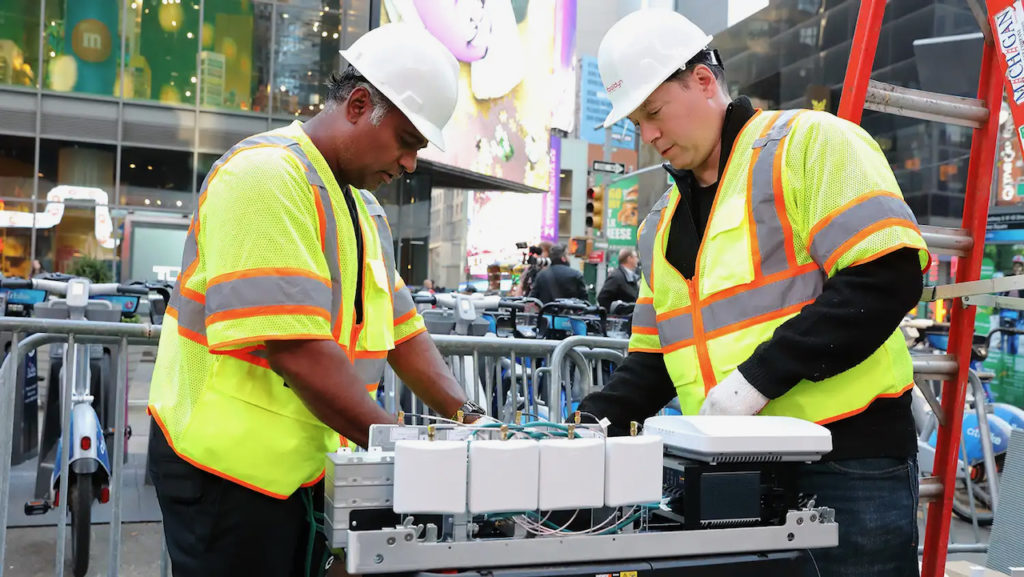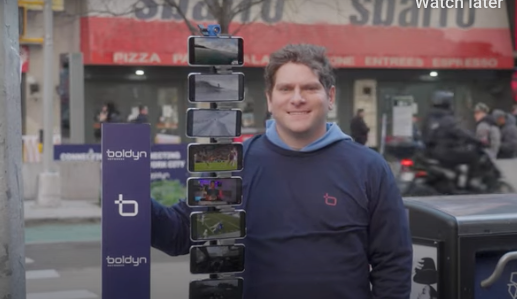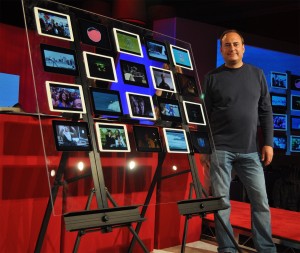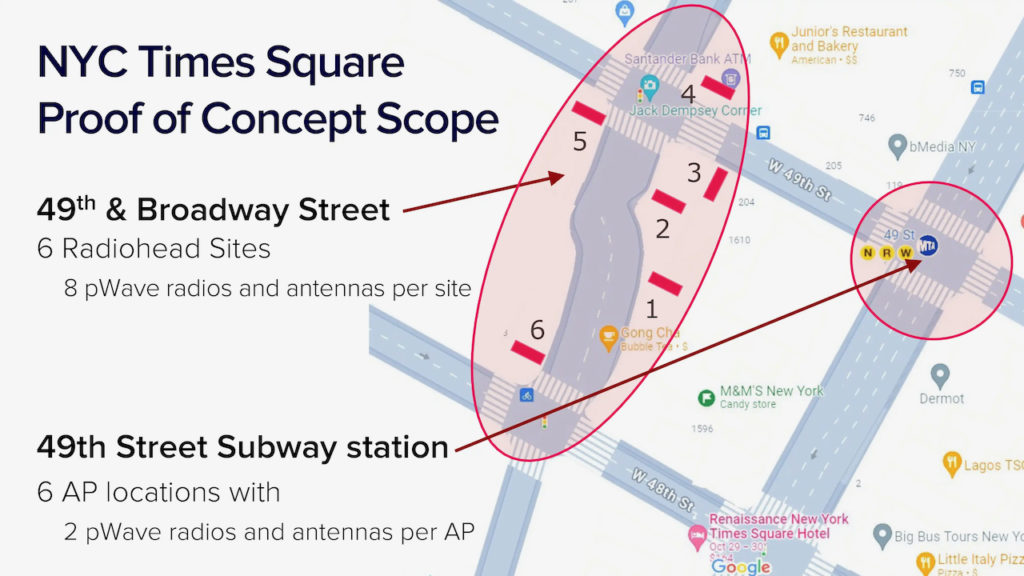
With a credible third-party deployment partner in hand, Artemis Networks hopes it may finally have what it needs to make its radically different mobile connectivity technology known as pCell a viable commercial wireless alternative.
A full 10 years and one week after first announcing pCell, Artemis announced the particulars of a proof of concept pCell wireless network it has been operating in Times Square in New York that it claims can handle “10 times the data capacity of the fastest 5G technology in the same amount of spectrum.” This performance, Artemis claims, is on a network that was installed in a matter of hours at a cost far below that of regular commercial cellular deployments.

But perhaps more important than the facts of the network performance and operational costs is that Artemis for the first time has a well-known connectivity infrastructure deployment partner in Boldyn Networks, which may be the key that finally gets Artemis inside the door to the commercially owned wiring closets, venues and other spaces where high-bandwidth connectivity equipment is needed.
While the technology explanations of how pCell works still require some advanced radio-frequency knowledge to even attempt to understand, the real barrier to commercial success for Artemis has always been the difficulty facing a small startup trying to find a way inside the big-company world of wireless networks.
By partnering with Boldyn, a company formed last year by the combination of assets held by BAI Communications that included longtime stadium and public infrastructure provider Mobilitie, Artemis finally has access to the kind of resources that can possibly get its “Artemis pCell Multi-Gigabit LTE/5G Network” technology at least to the purchasing-discussion tables of commercial wireless providers or large public venue owners.
“What we always needed was an infrastructure provider,” said Artemis founder and CEO Steve Perlman, who was once a well-known name in technology circles. “Now we have a global partner who can do the things we couldn’t do as a small technology vendor.”
Getting a chance to really display pCell performance
Like other previous tests Artemis has staged along the years, the performance numbers the company is claiming from its Times Square demonstration, in the words of Perlman, “sound too good to be true.” How about delivering 700 Mbps of bandwidth simultaneously to 128 phones all streaming video at the same time? Or lighting up a nearby subway tunnel with a similar low-cost, high-performing network? All done with just a relative handful of pCell radios and 20 MHz of 3.5 GHz spectrum?

“When you say it’s 10 times faster and much cheaper, everyone always asks, ‘what’s the catch?’,” Perlman said in a phone interview ahead of the announcement. “But there is no catch.”
As a long, long, longtime Silicon Valley entrepreneur whose claims to fame include working on QuickTime at Apple and building WebTV, Perlman knows how to put on a good techno show, and the videos and charts and graphs from the performance of the four-month pCell deployment in the heart of the Big Apple don’t disappoint. At one early demo of pCell capability in 2014, Perlman showed a wall of 20 iPads running HD video via one 5 MHz LTE channel.

But without any real public deployments along the decade-long path, it’s always been too easy for critics and market observers to write off the Artemis technology claims as something that works in a lab, or a demo, but not in the real world.
“It’s never been a question on our end, about the technology,” said the still-confident Perlman, whose company’s website notes the 150 academic papers and 350 “issued and allowed” patents surrounding the invention. Putting aside the details for now, what Artemis said it had developed with pCell was a way for regular LTE-compliant phones to communicate much faster for a far lower deployment cost, one that didn’t need to worry about RF interference tuning and other complicated, costly parameters of regular cellular network construction and operation. Believe that if you will, because there’s really nowhere you could see it or touch it in a live, commercial deployment.
But what has really hampered the public chances for pCell, Perlman admitted, was not the technology itself but instead his small company’s inability to perform the tasks necessary to make any technology work at scale — like handling customer service calls, or teaching installation crews how to correctly deploy and administer pCell networks.
In May of 2022, it looked like pCell might finally have found a way into the public spotlight, when the company announced that it had installed a CBRS-based pCell network inside SAP Center in San Jose, with its potential touted by the San Jose Sharks. However, the announced plans to make the network available to a full house of users at the 20,000-seat venue later that year never came to fruition, mainly because Artemis could not handle the necessary tasks like customer support by itself.
Technically, Artemis had solutions in place to allow for replacement SIMs or an eSim download via a QR code (pCell clients, like phones in other CBRS deployments, require a dedicated SIM to function), but it was the potential follow-on hands-on work that Perlman said his company couldn’t provide.
“If you have a public-facing network, someone may have a phone that’s locked, or it might be older and not have access to CBRS spectrum,” Perlman said. “Or it might just be broken, and the comm chip for that spectrum doesn’t work. For all that, you need a customer support line, someone to provide answers and support. We’re too small to do that. We’re a technology provider. We don’t have the ability to be customer-facing.”
Enter the infrastructure partner, one that not only knows how to get networks built and deployed, but can also talk carrier partners into paying to use them.
Through its Mobilitie arm, Boldyn has a long history of deploying neutral-host wireless networking solutions in venues, most recently at Crypto.com Arena in Los Angeles and at Rocket Mortgage Fieldhouse in Cleveland. The company also has deployment experience in public macro networks, and in transportation deployments, including the London Underground. While the press release did not mention any guarantees or signed deals for Boldyn to use pCell technology in a customer deployment, the companies did say that Boldyn has tested pCell in a 27,000-seat arena, with download speeds of 1 Gbps using just 20 MHz of bandwidth. Though the companies did not name the venue, it is most likely the Dignity Health Sports Park in Carson, Calif., a stadium where Mobilitie had previously deployed a distributed antenna system (DAS) as well as a CBRS network.

“Boldyn Networks is bringing together a strengthened portfolio of advanced technology assets and capabilities to reimagine the connected future of the NYC metro area,” said Christos Karmis, CEO of Boldyn’s U.S. business, in a prepared statement. “Testing new technology such as Artemis pCell in high-density urban, subway and venue settings helps us realize that vision and our commitment to the area.”
In an email reply to Stadium Tech Report, Karmis said pCell could theoretically be used in venues to deliver “high-capacity private networks to support in-venue content services,” or to build a high-capacity shared RAN for a neutral host network that wireless carriers could join, like a DAS.
So at the very least, Boldyn isn’t shy about attaching its public name to pCell. And if they can make a network together in New York, well, according to Sinatra they can make one anywhere. So what’s possible?
What can pCell do for you?
Like other network infrastructure providers, Boldyn is very active in the private networks space. Though nothing of any sort was announced in the release, it’s possible that Boldyn could offer pCell as a choice for private network deployments, in venues or in enterprise situations.
Perlman, who hasn’t stopped looking to the future, was showing off a pair of Ray-Ban Meta smart glasses on our video call, noting that such devices could be responsible for the next surge in arena bandwidth consumption.
“These things have a video camera and you can livestream to Instagram,” Perlman said. It didn’t take too much imagination to see a stadium filled with smart-glass wearers, who might be live-streaming the end of the Super Bowl or a song at a Taylor Swift concert.
“With these kind of glasses, you can watch the action and stream at the same time, without holding something in front of your face,” Perlman said. “This, not phones, is going to be the next thing that overwhelms stadium networks.”
Unless, of course, those venues install a pCell network to handle the traffic.
“We have a significant performance advantage, and a significant cost advantage,” said Perlman, comparing pCell to traditional wireless networks. “And now we’re vetted in a macro deployment that works in rain and snow, heat and cold.”







